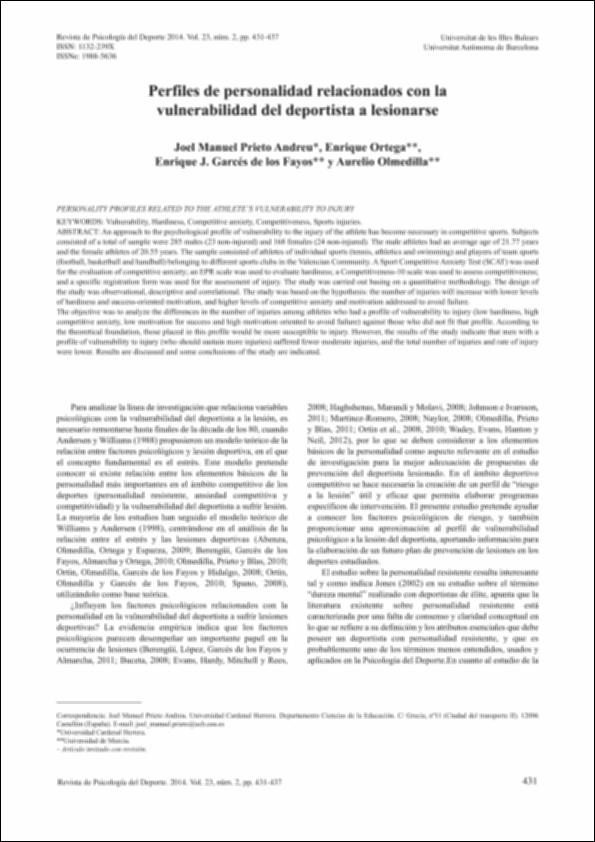Por favor, use este identificador para citar o enlazar este ítem:
http://hdl.handle.net/10637/7115Perfiles de personalidad relacionados con la vulnerabilidad del deportista a lesionarse
| Título : | Perfiles de personalidad relacionados con la vulnerabilidad del deportista a lesionarse |
| Autor : | Ortega Toro, Enrique Garcés de los Fayos Ruiz, Enrique Javier Olmedilla Zafra, Aurelio Prieto Andreu, Joel Manuel |
| Materias: | Deportistas - Personalidad.; Athletes - Personality.; Deportes - Aspectos psicológicos.; Sports - Psychological aspects.; Deportistas - Psicología.; Psychological test.; Deportes - Accidentes y lesiones.; Sports - Wounds and injuries.; Deportistas - Estrés.; Stress in athletes.; Evaluació psicológica.; Athletes - Psychology. |
| Editorial : | Universitat de les Illes Balears, Servei de Publicacions. |
| Citación : | Prieto Andreu, J.M., Ortega, E., Garcés de los Fayos, E.J. & Olmedilla, A. (2014). "Perfiles de personalidad relacionados con la vulnerabilidad del deportista a lesionarse". Revista de Psicología del Deporte, vol. 23, n. 2, pp. 431-437. |
| Resumen : | En el ámbito deportivo competitivo se hace necesaria una aproximación al perfil de vulnerabilidad psicológico a la lesión del deportista. La muestra total del estudio fue de 285 hombres (23 no lesionados) y 168 mujeres (24 no lesionadas), los hombres tenían una media de edad de 21.77 años y las mujeres de 20.55 años. La muestra estuvo compuesta por jugadores de deportes individuales (tenis, atletismo y natación) y por jugadores de deportes colectivos (fútbol, baloncesto y balonmano) pertenecientes a distintos Clubes Deportivos de la Comunidad Valenciana. Para la evaluación de la ansiedad competitiva, se utilizó el Sport Competitive Anxiety Test (SCAT); para evaluar la personalidad resistente, se utilizó la escala EPR; para evaluar la competitividad, se utilizó la escala de Competitividad-10; y, para la evaluación de las lesiones, se utilizó una hoja de registro específica. El diseño del estudio fue descriptivo, observacional y correlacional. El estudio partió de la siguiente hipótesis: el número de lesiones aumentará cuando menor sea la personalidad resistente y la motivación orientada al éxito, y cuando mayor sea la ansiedad competitiva y la motivación orientada a evitar el fracaso. Se planteó como objetivo analizar las diferencias en el número de lesiones entre los deportistas que presentaban un perfil de vulnerabilidad a la lesión frente a los que no presentaban dicho perfil. Según la fundamentación teórica, situarse en dicho perfil implicaría lesionarse más, sin embargo, los resultados del estudio indican que los hombres con perfil de vulnerabilidad a la lesión (los que se lesionarían más) tuvieron menor número de lesiones moderadas, totales e índice de lesión. Se discuten los resultados y se señalan algunas conclusiones del estudio. An approach to the psychological profile of vulnerability to the injury of the athlete has become necessary in competitive sports. Subjects consisted of a total of sample were 285 males (23 non-injured) and 168 females (24 non-injured). The male athletes had an average age of 21.77 years and the female athletes of 20.55 years. The sample consisted of athletes of individual sports (tennis, athletics and swimming) and players of team sports (football, basketball and handball) belonging to different sports clubs in the Valencian Community. A Sport Competitive Anxiety Test (SCAT) was used for the evaluation of competitive anxiety; an EPR scale was used to evaluate hardiness; a Competitiveness-10 scale was used to assess competitiveness; and a specific registration form was used for the assessment of injury. The study was carried out basing on a quantitative methodology. The design of the study was observational, descriptive and correlational. The study was based on the hypothesis: the number of injuries will increase with lower levels of hardiness and success-oriented motivation, and higher levels of competitive anxiety and motivation addressed to avoid failure. The objective was to analyze the differences in the number of injuries among athletes who had a profile of vulnerability to injury (low hardiness, high competitive anxiety, low motivation for success and high motivation oriented to avoid failure) against those who did not fit that profile. According to the theoretical foundation, those placed in this profile would be more susceptible to injury. However, the results of the study indicate that men with a profile of vulnerability to injury (who should sustain more injuries) suffered fewer moderate injuries, and the total number of injuries and rate of injury were lower. Results are discussed and some conclusions of the study are indicated. |
| URI : | http://hdl.handle.net/10637/7115 |
| Derechos: | http://creativecommons.org/licenses/by-nc-nd/4.0/deed.es |
| ISSN : | 1988-5636 (Electrónico). 1132-239X |
| Fecha de publicación : | 1-abr-2014 |
| Aparece en las colecciones: | Dpto. Ciencias de la Educación |
Los ítems de DSpace están protegidos por copyright, con todos los derechos reservados, a menos que se indique lo contrario.


